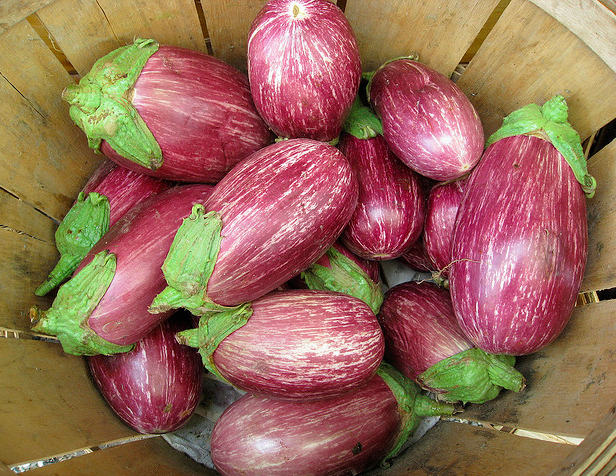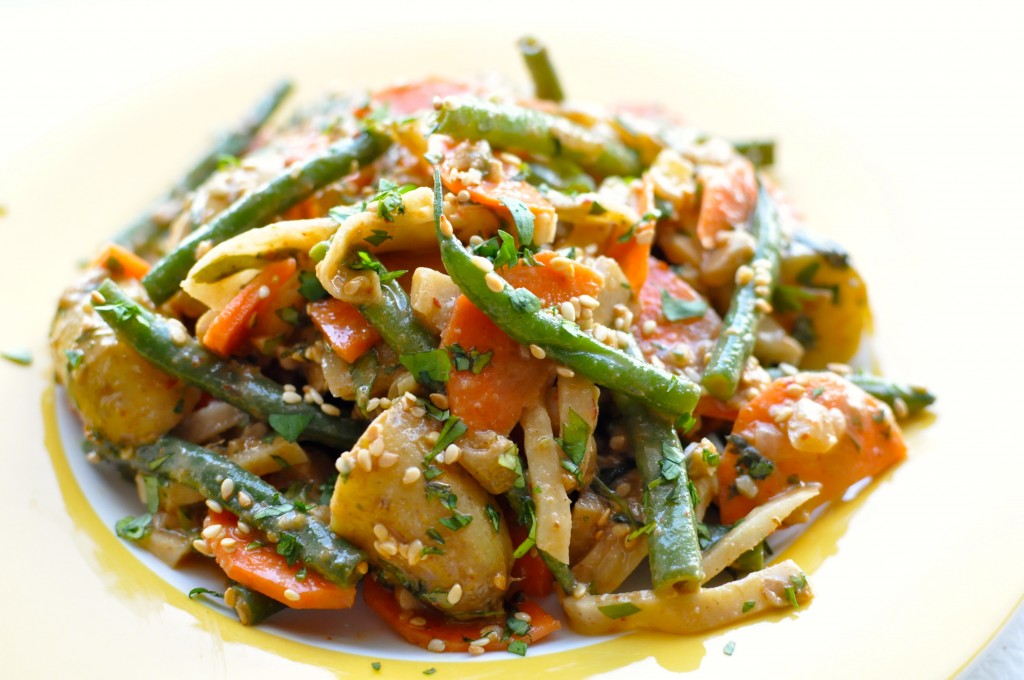
I’m very excited to have finally found some end of season tomatillos. I’ve never cooked with them before, but have spent many a moment entranced by these exotic creatures with their wispy, paper-like husks. In the past when I’ve been lucky enough to spot them, I just stare and stare at the farmers’ market then, overwhelmed by the novelty, I scurry off and pick up something far more prosaic and familiar, like an eggplant. But not this week. This week, I put six plump specimens in my basket and toddled off brimming with ideas on what to do with them.
When tomatillo season comes round, food sites and magazines always seem to offer recipes for one staple, salsa. Sometimes the tomatillos are roasted to concentrate their fresh tomato-esque flavors and mellow their acidic bite, at other times they’re used fresh to maximize their characteristic tang. I do like a good salsa, but I wanted to try something a little different with my tomatillos. Still, not wanting to stray far from traditional applications, I delved into Diana Kennedy’s The Art of Mexican Cooking for inspiration. Kennedy offers a cooked “green” table sauce made from tomatillos simmered with garlic, cilantro and serrano chiles that serves as a multi-purpose piquant base or accompaniment for many central Mexican dishes. Mmmm, now this was on the right track, but it didn’t quite hit the spot. I then recalled a hearty, spicy pork dish I’d often seen at authentic taquerias, but actually never tried, chile verde, and wondered whether the tomatillo played a role there. Lucky hunch.
Played a role? Just a few seconds on Google and I discovered the tomatillo is the star of the dish. The recipe below is an amalgamation of several “authentic” versions I came upon. The one that it most closely resembles is by “Elise,” on Simply Recipes. And for the record, that’s Elise’s Chile Verde in the photo up top. I suggest using canned green chiles rather than roasting and peeling fresh chiles (which you can do if you like). The flavor might a suffer a touch, but you’ll save a lot of time.
When buying, look for fruit that’s firm, dry and snug inside their husks. Be sure to avoid any that are moldy or soft or oozing any sticky fluids. Tomatillos will ripen to yellow, but it’s best to use to cook with them when they are still green. When you come to prepare them, peel off the husks by hand, then gently swish the fruit around in cold water to remove the viscous coating. Store tomatillos in the fridge in a paper bag, for up to 1 month.
Chile Verde
3/4 pound tomatillos
1/2 cup packed cilantro leaves with some stem
3 cloves garlic, peeled and roughly chopped
1/3 cup canned green chiles (or if you like, use the same amount of roasted, peeled and seeded mixed green chiles)
1 1/2 cups chicken broth
2 pounds pork butt, trimmed of fat and cubed into 1-inch pieces
Salt and freshly ground pepper
2 tablespoon olive oil
1 medium onion, chopped
1 small yellow bell pepper, seeded and chopped into small dice
2 teaspoons ground cumin
1/2 teaspoon dried oregano
Chopped fresh cilantro leaves, to garnish
Preheat the broiler to low. Remove the papery husks from the tomatillos and wash off the sticky coating. Slice 2/3 of them in half horizontally, setting aside the remainder. Arrange the sliced tomatillos, cut side down, on a lightly greased cookie sheet. Broil the cut tomatillos for about 10 minutes or until the skins are blistered and slightly blackened. Remove from the oven and leave to cool.
Place the broiled tomatillos, skins, seeds and all in a blender. Chop up the remaining tomatillos and add them to the blender together with the cilantro, garlic, chiles and 1/2 cup chicken broth. Blend until smooth. Set aside.
Season the pork generously with salt and pepper. Heat the oil in a large, heavy-based Dutch oven over medium-high heat. When hot add half the pork in two batches. Sear the meat until well browned all over. Transfer to a bowl using a slotted spoon, and repeat with the remaining pork. Set aside the pork. Pour off all but 1 tablespoon of oil from the pot. Add the chopped onion and bell pepper and cook until tender and golden, stirring occasionally, about 6 to 8 minutes. Add the cumin and cook and cook for a further 1 minute, stirring. Return the pork to the pot together with the blended tomatillo mixture (saving 1/4 cup), the remaining chicken broth, oregano, 1/2 tsp salt and plenty of black pepper. Cover and simmer until the pork is tender, about 2 hours.
Stir in the remaining blended tomatillo mixture, then taste and add more salt if necessary. Serve with warm tortillas or rice, garnished with chopped fresh cilantro. This stew can be made up to 2 days ahead. Cool after cooking, then cover and refrigerate. Heat thoroughly before serving.
 (image)
(image)

